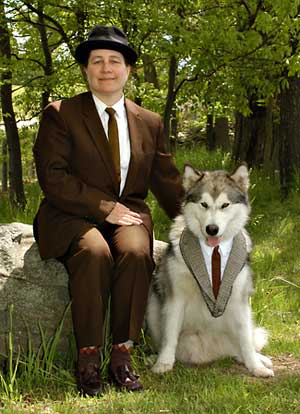Sit. Stay. Roll over. These are common commands that most dogs learn to obey. But dance? Tell that to most dogs and you may receive a blank stare.

For Peg Ash Sturtz, dog dancing is a shared love with her 2-year-old Alaskan Malamute, Chimo. Dog dancing is a form of competition in which owner and dog must work together in a choreographed routine that includes walking, running, spinning, jumping, backing up, and in the case of Chimo, “high-fiving” his master.
“I have done a lot of training and competing but am new to dog dancing,” says Sturtz, who adopted Chimo when he was 11 months old. “I needed something to do with him that I wasn’t doing with other dogs.”
Sturtz, a teller in the cashier’s office at U-M-Flint, also owns a female Alaskan Malamute named Q. She came from the same litter as Chimo and competes in conformation and agility competitions.
After just five months of practice Sturtz and Chimo made their dancing debut last Memorial Day weekend at the Motown Bow Wow Boogie in Davisburg, Mich.—a competition to highlight canine training.
Dressed in outfits fashioned in the style of famous TV private investigator Peter Gunn, the duo performed well, Sturtz says. Their routine included sneaking movements and quiet steps to simulate investigators. She says the biggest change for Chimo from his practice routine was competing in a large arena with loud music.
“He took to it very well,” she says of the dance routines, which can run anywhere from 1 minute and 30 seconds to more than 2 minutes. “All eyes are on you; it’s just you and your dog.”
Sturtz and Chimo practice Thursday mornings at the Companion Dog Training Club of Flint. They will return to the Motown Bow Wow Boogie May 27-29 in hopes of achieving beginner status before moving up to the novice category.
“We are going to practice and do better,” she vows. “But I really don’t care how he does; he’s just very special.”
While Sturtz praises Chimo’s enthusiasm and ability to dance and move around an arena, she also appreciates how he can lie down and be calm for an audience of children.
Chimo participates in the “Tell-a-Tail” program in the Flint area. The first Friday of every month, Sturtz takes him to Good Shepherd Lutheran School to participate in a unique reading program. There, children read to dogs. The canines serve as captive, non-judgmental audience members.
Chimo, a certified therapy dog, became a little too excited when he made his first “Tell-a-Tail” appearance in December. “He jumped on the kids and just wanted to play with them,” Sturtz says, but she adds that Chimo became a much better listener at the January reading.
Plus, Sturtz says, she always has an advantage when it comes to making Chimo behave. “I use treats a lot when I train him,” she says. “He is pretty happy to do anything for a cookie.”

